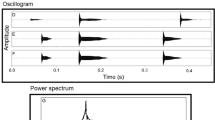Summary
It was the aim of this work to investigate the effects of meteorological factors on two types of behavior related to vocalization in two species of anuran amphibians (Bufo calamita and Hyla arborea). The measurements were carried out in two gravel pits in the Kanton of Zurich. Evaluation by multiple linear regression was carried out at the computer Center of Zurich University. It could be shown that water temperature at 1900 was the most important factor for the onset of callings in both species. Air pressure (for both species) and amount of rainfall on the previous day and shunshine on the same day (for Bufo calamita) played a less important but significant role for this type of behavior. In both species, water temperature at 2400 was the important factor for the duration of the mating chorus. In addition, the amount of rainfall on the previous day and sunshine on the same day had a slight but significant effect on this type of behavior in Bufo calamita. The validity of the method and the results are discussed.
Similar content being viewed by others
References
Birukow, G.: Über den Einfluß barometrischer Luftdruckschwankungen auf die Phototaxis des Kornkäfers Calandra granaria L. Nachr. Akad. Wiss. Göttingen 18 (1964).
Blair, W. F.: Mating call in the speciation of anuran amphibians. Amer. Naturalist 92, 27–51 (1958).
Blankenhorn, H. J.: Tageszeitlicher und jahreszeitlicher Ablauf der Lautaktivität einiger einheimischer Amphibien. Diplomarbeit an der Universität Zürich, 1968 (unpublished).
Blankenhorn, H. J., Burla, H., Müller, P., Villiger, M.: Die Bestände an Amphibien zur Laichzeit in drei Gewässern des Kantons Zürich. Vjschr. naturforsch. Ges. Zürich 114(3), 255–267 (1969).
Capranica, R. R.: The vocal repertoire of the bullfrog (Rana catesbeiana). Behaviour 31, 302–325 (1968).
Eakin, H. R.: A third eye. Sci. Amer. 58, 73–79 (1970).
Eibl-Eibesfeld, I.: Zur Paarungsbiologie des Laubfrosches Hyla arborea L. L. Z. Tierpsychol. 9, 338 (1953).
Eibl-Eibesfeld, I.: Zur Paarungsbiologien der Gattungen Bufo, Hyla, Rana und Pelobates. Zool. Anz. 19 (Suppl.), 315–323 (1956).
Flindt, R., Hemmer, H.: Die Parameter für das Einsetzen der Paarungsrufe bei Bufo calamita und Bufo viridis. Salamandra 3, 98–100 (1967).
Günther, R.: Paarungsrufe und reproduktive Isolationsmechanismen bei europäischen Anuren der Gattung Rana. forma et functio 1, 263–284 (1969).
Guyétaud, P., Robert, M.: Répartitions des amphibiens anours du Doubs. Ann. sci. Univ. Besancon 3, 16–18 (1965).
Heusser, H.: Die Bedeutung der äußeren Situation im Verhalten einiger Amphibienarten. Rev. suisse Zool. 68, 1–39 (1961).
Heusser, H.: Der rudimentäre Ruf der männlichen Erdkröte (Bufo bufo). Salamandra 5, 46–56 (1969).
Heusser, H.: Lautäußerung des Wasserfrosches Rana esculenta L. Aqua Terra 12, 150–151 (1969).
Heusser, H.: Paarungs-und Befreiungsruf der Erdkröte Bufo bufo. Z. Tierpsychol. 27, 894–898 (1970).
Heusser, H., Meisterhans, K.: Zur Populationsdynamik der Kreutkröte Bufo calamitaLaur. Vjschr. naturforsch. Ges. Zürich 114(3), 269–277 (1969).
Hinde, R. A.: Animal behaviour, 2nd ed. New York: McGraw Hill 1970.
Littlejohn, M. J.: Call differentian in a complex of seven species of Crina. Evolution, 13, 452–471 (1959).
Littlejohn, M. J.: Call discrimination by females of the spotted chorus frog Pseudacris darki. Texas J. Sci. 13, 49–50 (1961).
Martof, B. S.: Vocalization as an isolating mechanism in frogs. Amer. Midland Nat. 65, 118–126 (1961).
Martof, B. S., Thompson, E. E.: Reproductive behaviour of the chorus frog Pseudacris nigrita. Behaviour 13, 234–258 (1958).
Martof, B. S., Thompson, E. E.: A behavioural analysis of the mating call of the chorus frog Pseudacris nigrita. Amer. Midland Nat. 71, 198–209 (1964).
Schneider, H.: Bio-Akustik der Froschlurche. Stuttg. Beitr. Naturk. 152, 1–16 (1966).
Schneider, H.: Paarungsrufe einheimischer Froschlurche. Z. Morph. Ökol. Tiere 57, 119–136 (1966).
Schneider, H.: Ruf und Rufverhalten des Laubfrosches Hyla arborea arborea. Z. vergl. Physiol. 61, 174–189 (1967).
Schneider, H.: Bio-akustische Untersuchungen am Mittelmeerlaubfrosch. Z. vergl. Physiol. 61, 369–385 (1968).
Wahl, M.: Untersuchungen zur Bio-Akustik des Wasserfrosches Rana esculenta. Oecologia 3, 14–55 (1969).
Author information
Authors and Affiliations
Additional information
This work was supported by a grant of “Schweizerischer Nationalfonds zur Förderung der wissenschaftlichen Forschung” to H. Heusser, Forch-Zürich, Switzerland.
Rights and permissions
About this article
Cite this article
Blankenhorn, H.J. Meteorological variables affecting onset and duration of calling in Hyla arborea L. and Bufo calamita calamita Laur. Oecologia 9, 223–234 (1972). https://doi.org/10.1007/BF00345233
Received:
Issue Date:
DOI: https://doi.org/10.1007/BF00345233




